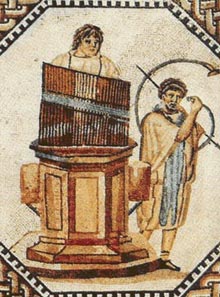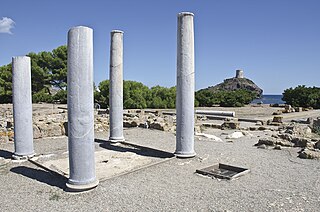Related Research Articles

Archaeological evidence of prehistoric human settlement on the island of Sardinia is present in the form of nuraghes and other prehistoric monuments, which dot the land. The recorded history of Sardinia begins with its contacts with the various people who sought to dominate western Mediterranean trade in classical antiquity: Phoenicians, Punics and Romans. Initially under the political and economic alliance with the Phoenician cities, it was partly conquered by Carthage in the late 6th century BC and then entirely by Rome after the First Punic War. The island was included for centuries in the Roman province of Sardinia and Corsica, which would be incorporated into the diocese of Italia suburbicaria in 3rd and 7th centuries.

Camulodunum, the Ancient Roman name for what is now Colchester in Essex, was an important castrum and city in Roman Britain, and the first capital of the province. A temporary "strapline" in the 1960s identifying it as the "oldest recorded town in Britain" has become popular with residents and is still used on heritage roadsigns on trunk road approaches. Originally the site of the Brythonic-Celtic oppidum of Camulodunon, capital of the Trinovantes and later the Catuvellauni tribes, it was first mentioned by name on coinage minted by the chieftain Tasciovanus some time between 20 and 10 BC. The Roman town began life as a Roman legionary base constructed in the AD 40s on the site of the Brythonic-Celtic fortress following its conquest by the Emperor Claudius. After the early town was destroyed during the Iceni rebellion in AD 60/61, it was rebuilt, reaching its zenith in the 2nd and 3rd centuries. During this time it was known by its official name Colonia Claudia Victricensis, often shortened to Colonia Victricensis, and as Camulodunum, a Latinised version of its original Brythonic name. The town was home to a large classical temple, two theatres, several Romano-British temples, Britain's only known chariot circus, Britain's first town walls, several large cemeteries and over 50 known mosaics and tessellated pavements. It may have reached a population of 30,000 at its height.

The Farnese Hercules is an ancient statue of Hercules, probably an enlarged copy made in the early third century AD and signed by Glykon, who is otherwise unknown; the name is Greek but he may have worked in Rome. Like many other Ancient Roman sculptures it is a copy or version of a much older Greek original that was well known, in this case a bronze by Lysippos that would have been made in the fourth century BC. This original survived for over 1500 years until it was melted down by Crusaders in 1205 during the Sack of Constantinople. The enlarged copy was made for the Baths of Caracalla in Rome, where the statue was recovered in 1546, and is now in the Museo Archeologico Nazionale in Naples. The heroically-scaled Hercules is one of the most famous sculptures of antiquity, and has fixed the image of the mythic hero in the European imagination.

The Province of Salerno is a province in the Campania region of Italy.

A cornu or cornum was an ancient Roman brass instrument about 3 m (9.8 ft) long in the shape of a letter 'G'. The instrument was braced by a crossbar that stiffened the structure and provided a means of supporting its weight on the player's shoulder. Some specimens survive in the archaeological record, two from the ruins of Pompeii.


The Province of Sardinia and Corsica was an ancient Roman province including the islands of Sardinia and Corsica.


The Battle of Decimomannu or Caralis took place in Sardinia when a Carthaginian army sailed to the island to support a local revolt against Roman rule. The army, led by Hasdrubal the Bald, fought a similar size Roman army under the Praetor Titus Manlius Torquatus in the Fall of 215 BC somewhere between Sestu and Decimomannu, just north of Caralis. The Romans destroyed the Carthaginian army and then scattered their fleet in a sea battle south of Sardinia.

Castelsardo is a town and comune in Sardinia, Italy, located in the northwest of the island within the Province of Sassari, at the east end of the Gulf of Asinara. It is a member of the I Borghi più belli d'Italia association.


The Nuragic civilization, also known as the Nuragic culture, was a civilization or culture on the Mediterranean island of Sardinia, Italy, which lasted from the 18th century BC up to the Roman colonization in 238 BC. Others date the culture as lasting at least until the 2nd century AD and in some areas, namely the Barbagia, to the 6th century AD or possibly even to the 11th century AD.

Monte d'Accoddi is a Neolithic archaeological site in northern Sardinia, located in the territory of Sassari. The site consists of a massive raised stone platform thought to have been an altar. It was constructed by the Ozieri culture or earlier, with the oldest parts dated to around 4,000–3,650 BC.

Nostra Segnora de Mesumundu is a religious building in the territory of Siligo, Sardinia, Italy.

The Temple of Antas is an ancient Carthaginian-Roman temple in the commune of Fluminimaggiore, southern Sardinia, Italy. It is located in an area colonised by the Carthaginians and then by the Romans, attracted by its silver and lead deposits.

Sardinia is the second largest island in the Mediterranean Sea and an autonomous region of Italy. Tourism in Sardinia is one of the fastest growing sectors of the regional economy. The island attracts more than a million tourists from both Italy, from the rest of Europe, and, to a lesser degree, from the rest of the world. According to statistics, tourist arrivals in 2016 were 2.9 million people.

Su Romanzesu is an archaeological site that is located near Bitti, Nuoro Province, Sardinia.

Yerevan railway station is the central station of Yerevan, the capital of Armenia, located south of downtown Yerevan, approximately 2.8 km from Republic Square.

The Byzantine age in Sardinian history conventionally begins with the island's reconquest by Justinian I in 534. This ended the Vandal dominion of the island after about 80 years. There was still a substantial continuity with the Roman phase at this time. The invasion of Italy by the Longobards in 568, which changed the face of Italy, only resulted in a few coastal raids on Sardinia.
References
- ↑ Raimondo Zucca. "Cornus". Archived from the original on 19 November 2011. Retrieved 24 March 2017.
- ↑ "Well temples and springs - the water cult in Nuragic Sardinia". 16 October 2011. Retrieved 29 May 2016.